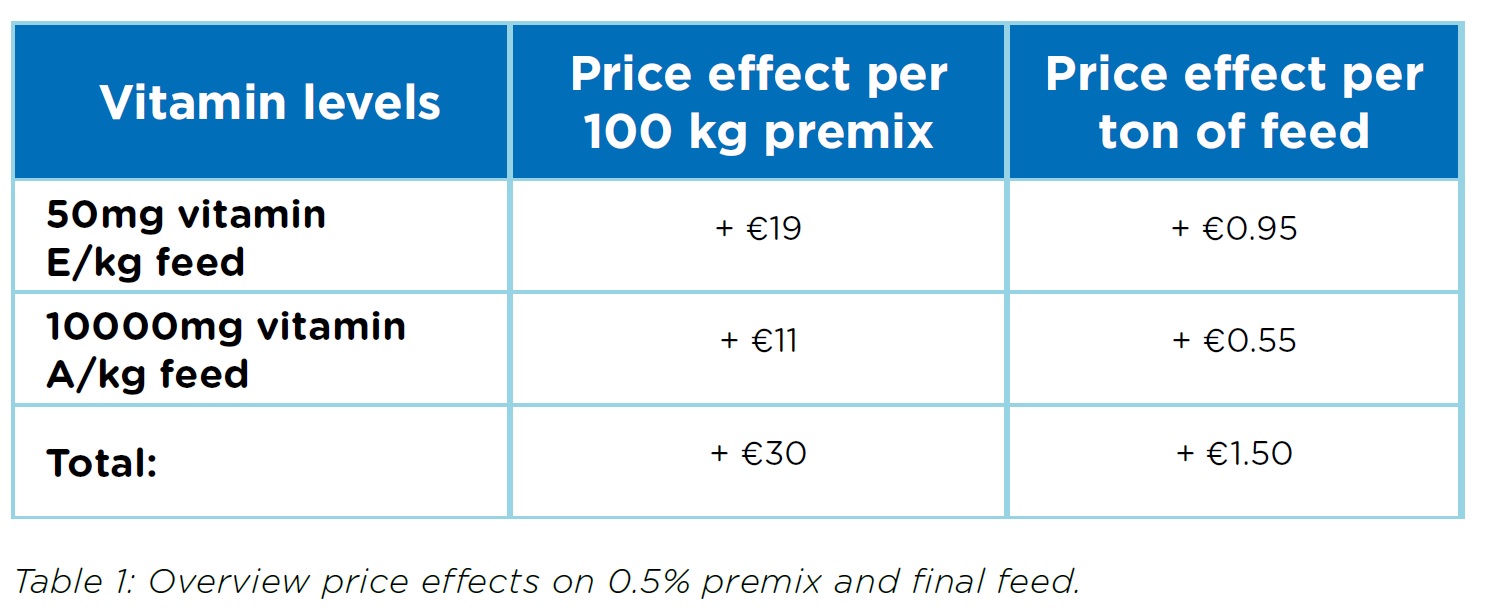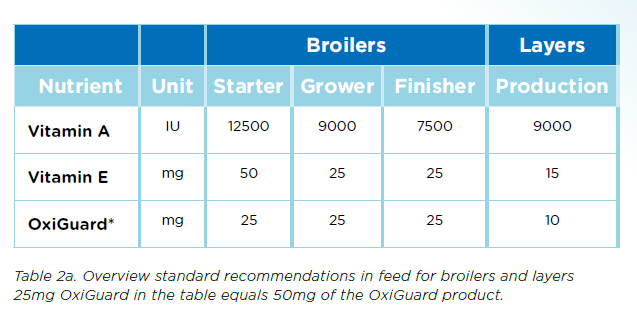Update on vitamin A and E situation
Due to severe problems in a major supplier's German factory, the production of vitamin E, A and colorant has stopped and the company has announced a force majeure. This will have a direct impact on the price and global availability of these products in the coming months.

In this article we want to inform you about:
- The current situation regarding vitamin A and E supply
- The actual effect on price, and our expectations
- Possibilities to mitigate the negative effects of higher prices and potential reduced availability on poultry, pigs and ruminants
Current market situation
Directly after the announcement, all other producers stopped offering these ingredients. A few days later, spot prices at traders doubled and have been increasing since. At the time of writing, the price for vitamin E is around €20 per kg for prompt delivery, and vitamin A is over €55 per kg.
It doesn’t look like the market will settle in the short term, so higher prices can be expected for the next two quarters. A price increase is inevitable in the coming period, but at Koudijs we expect to be able to supply premixes to all our loyal customers in the volumes you normally order.
Effect on premix and feed pricing
Price effects on premix and feed can be calculated, assuming a 0.5% premix and a price increase of vitamin E from €8.50 to €18 and vitamin A1000 from €20 to €55.

It's clear that the current price increases for vitamin A and E have a big impact on premix prices but also on feed prices. It's therefore advisable to review the current levels of vitamin A and E in your feeds and consider other options. We can also introduce you to OxiGuard, a product containing a blend of natural polyphenols with antioxidative properties, capable of reducing vitamin E in your feed. For more details about OxiGuard, see the article elsewhere in this newsletter.
Possibilities to mitigate the effects of high prices of vitamin A and E
Before looking at minimum requirement levels of vitamin A, E and alternatives, it's good to be aware of the essential role vitamin A and E play in the metabolism of animals (see boxes). Two obvious options should be considered: Can you lower the levels of vitamin A and E in feed and are there alternatives?
Polyphenols – maintaining antioxidative status with lower vitamin E
Polyphenols are secondary plant metabolites which contain bioactive components and are characterised by multiple phenol units. They are an important group of exogenous antioxidants of which the antioxidant capacity is comparable to that of vitamin E and C. The hydroxyl group on the phenolic ring of polyphenols can transfer a hydrogen atom to a free radical without the polyphenol becoming unstable. Depending on the structure of a polyphenol, more than one donation to a free radial can occur. Secondly, polyphenols are also able to donate an electron to already used antioxidants, such as vitamins E and C allowing these vitamins to regenerate and regain their functions.
At Koudijs, we have carefully selected and tested the best polyphenols based on their antioxidative capacity. After three years of research, the result is a blend of polyphenols on a carrier which we call OxiGuard, a product comparable with vitamin E 500 on a 1:1 basis.
Advice regarding poultry
Vitamin A and E are essential for offspring to have a good start. They are provided via the yolk. We don’t recommend using the lowest limits in breeders, because this can lead to future problems with day-old chicks, young broilers and rearing laying flocks.
Our research has shown that vitamin A can be lowered considerably with broilers, but not in the starter phase of day-old chicks. We advise keeping the same level in (pre-)starter feeds, and possibly reducing vitamin A in the following phases. After rearing, vitamin A is well stored in the liver. However, due to challenging changes during the production peak, we recommended considering a lower vitamin A level only after the peak period.
Where vitamin E is used as an oxidant, it's possible to partly reduce vitamin E and add a natural source of polyphenols like OxiGuard. Depending on the level of vitamin E in the feed, selenium, the quality of the raw materials used in the feed, production conditions and challenges at farm level, typically up to 50% of the vitamin E can be reduced to the levels indicated in Table 2a complemented with OxiGuard.

Ad *: 25mg OxiGuard in the table equals 50mg of the OxiGuard product.
Advice regarding pigs
In pigs, the advice is often to use a higher vitamin A level than strictly required from a nutritional point of view under 'standard' conditions. It’s stated on the feed label that there is a ‘commercial perspective’, but there is also an assurance that there is sufficient vitamin A under all circumstances at customer level. As in poultry in reproduction and piglets, caution is recommended in using the lowest limits published.
Vitamin E, like vitamin A, inclusions are often higher than minimum nutritional recommendations found in literature. This is partially for commercial reasons but often to support health and fertility of the animals or to improve meat quality. So depending on your customers' farm challenges or a slaughterhouse's production goals, vitamin E recommendations can vary widely.
Table 2b shows an overview of typical standard recommendations. For vitamin E levels higher then mentioned in Table 2b, we recommend replacing that part with 50% vitamin E and 50% OxiGuard.

Ad*: Higher vitamin E levels can be used and recommended for many reasons.
Advice regarding ruminants
Because Vitamin A and E both play an important role in immunity and fertility in ruminants, a wide range between the minimum level required for normal functioning under 'standard' conditions and levels used to support maximum immunity (health) and fertility can be found.
Forages can contribute significantly to the total daily supply of vitamin A and E but vary widely depending on weather conditions, field period and type of crop, therefore only additional vitamin A and E is normally calculated. Table 2c gives an overview of typical levels used in the industry.
Ad*: Higher vitamin E levels can be used for many reasons. For levels above mentioned requirements it is possible to replace vitamin E by 50% vitamin E and 50% OxiGuard
Summary
Vitamins A and E are much more expensives, but a slight decrease can now be noted. We expect to be able to supply premixes to our customers, based on expected volumes. The higher prices have a significant impact on premix and feed prices. It's therefore recommended that you review your vitamin A and E premix levels and consider the option of using polyphenols as an antioxidant (OxiGuard). Our technical specialists are more than happy to review your situation with you.





